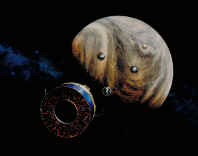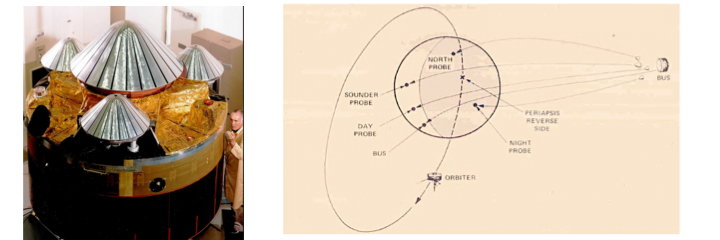- A radar map of the surface at 75 Km resolution
- Characterization of Venus’ interaction with the solar wind setting limits on Venus” magnetic field
- Established sulfuric acid content of cloud deck
- Measured a decline in sulfuric acid in the atmosphere and detected implying active volcanic activity

Introduction
The Pioneer Venus Mission consisted of two major parts: the Multiprobe and the Orbiter. The Multiprobe was composed of the carrier or Bus (290 kg); Sounder, a large probe (315 kg) and 3 smaller probes (90 kg each). It was launched on August 8, 1978 and reached Venus on December 9, 1978. Sounder was released from the Bus on November 15, 1978 followed by 3 smaller probes on Nov 19, 1978.
Pioneer Venus Probes and Bus - Atmospheric Entry **
All times in UT (= EST + 5 hours) on December 9, 1978
| Large Probe | North Probe | Day Probe | Night Probe | Bus | |
|---|---|---|---|---|---|
| Entry Time (200 km) | 18:45:32 | 18:49:40 | 18:52:18 | 18:56:13 | 20:21:52 |
| Impact Time | 19:39:53 | 19:42:40 | 19:47:59 | 19:52:05 | * |
| Loss of Signal | 19:39:53 | 19:42:40 | 20:55:34 | 19:52:07 | 20:22:55 |
| Impact Latitude | 4.4 N | 59.3 N | 31.3 S | 28.7 S | (37.9 S) |
| Impact Longitude | 304.0 | 4.8 | 317.0 | 56.7 | (290.9) |
| Solar Zenith Angle | 65.7 | 108.0 | 79.9 | 150.7 | 60.7 |
| Local Venus Time | 7:38 | 3:35 | 6:46 | 0:07 | 8:30 |
| *Bus signal at 110 km altitude | |||||
| ** Information from NSSDC web site. |
The orbiter carried 16 instruments (total mass 45 kg) to study plasma interaction with the upper atmosphere, make multi-wavelength observations of the clouds and to map the surface with radar. It was launched on May 20,1978 and reached orbit on Dec 4, 1978. Entry into the atmosphere ended the mission on Oct 8, 1992. (See NASA SP-461 by Fimmel, Colin and Burgess for a general review of the mission.)
Some achievements during the 14 Year mission were
References
The initial descriptions for the mission, its goals and instrumentation is given in
Space Science Reviews, 20(3), 248-354, 1977a. https://link.springer.com/journal/11214/20/3 and Space Science Reviews, 20(4), 356-525, 1977b. https://link.springer.com/journal/11214/20/4
Colin, L., Encounter with Venus, Science, 203, No. 4382, 743-745, Feb. 1979.
An introduction to the JGR special issue covering results is given by Colin, L, The Pioneer Venus Program , Journal of Geophysical Research, VOL. 85, NO. A13, Pages 7575-7598, December 30, 1980, which includes a detailed bibliography.
Searching for Additional Publications via Author or topic
Access to Data
The Pioneer Venus Multiprobe - These data are listed in NSSDCA as Pioneer Venus Special events - Note: This master catalog allows you to search for data set descriptions. Clicking on an entry in the left column gives you a description of the data. Clicking on Coordinated Request and User Support Office located in the right column of that page allows you to order the offline data.
The Bus made measurements down to 110 km altitude. A region not sampled by the probes. It was equipped with a BNMS - neutral mass spectrometer and a BIMS - ion mass spectrometer.
Sounder, the large probe was equipped with a parachute and carried seven experiments:
LMNS - A neutral mass spectrometer to measure the atmospheric composition
LGC - A gas chromatograph to measure the atmospheric composition
LSFR - A solar flux radiometer to measure solar flux penetration in the atmosphere
LIR - An infrared radiometer to measure distribution of infrared radiation
LCPS - A cloud particle size spectrometer to measure particle size and shape
LN/SN - A nephelometer to search for cloud particles
LAS/SAS - Temperature, pressure, and acceleration sensors
LGC - A gas chromatograph to measure the atmospheric composition
LSFR - A solar flux radiometer to measure solar flux penetration in the atmosphere
LIR - An infrared radiometer to measure distribution of infrared radiation
LCPS - A cloud particle size spectrometer to measure particle size and shape
LN/SN - A nephelometer to search for cloud particles
LAS/SAS - Temperature, pressure, and acceleration sensors
The three smaller identical probes had no parachutes and carried
LN/SN - A nephelometer
LAS/SAS - Temperature, pressure, and acceleration sensors
SNFR - A net flux radiometer experiment to map the distribution of sources and sinks of radiative energy in the atmosphere.
LAS/SAS - Temperature, pressure, and acceleration sensors
SNFR - A net flux radiometer experiment to map the distribution of sources and sinks of radiative energy in the atmosphere.
MWIN - Doppler information was received from all four probes that were targeted for different locations on the planet.
Pioneer Venus Orbiter - The NSSDCA lists various data sets for ONMS, OAD, OUVS, ORO, OGPE, OTUR, OCPP, OIR, OPA, OMAG, OETP, OIMS, ORPA, OEFD, ORAD, OIDD, OGBD and OCM.
Note: This master catalog allows you to search for data set descriptions. Clicking on an entry in the left column gives you a description of the data. Clicking on Coordinated Request and User Support Office located in the right column of that page allows you to order the offline data.
ORSE Orbiter Radio Science Experiment
POS Spacecraft Position
ORPA Retarding Potential Analyzer
ORO - A radio occultation experiment to characterize the atmosphere
OGPE - A radio science atmospheric and solar wind turbulence experiment.
OTUR - Radio Occultation Atmospheric Turbulence
Clouds
Solar Wind and Ionosphere
Surface and Interior
POS Spacecraft Position
ORPA Retarding Potential Analyzer
Composition and Structure of the Atmosphere
ONMS Orbiter Neutral Mass Spectrometer
OAD - An atmospheric drag experiment to study the upper atmosphere.
OUVS - An airglow ultraviolet spectrometer to measure scattered and emitted UV light
OAD - An atmospheric drag experiment to study the upper atmosphere.
OUVS - An airglow ultraviolet spectrometer to measure scattered and emitted UV light
These data are archived in the Atmospheres Node (ATM) pv01_1001, pv01_1002 (Pioneer Venus Orbiter OUVS Inbound Monochrome Images)
These volumes contain Inbound Monochrome Images (IMIDR) produced from the Orbiter Ultraviolet Spectrometer (OUVS) instrument. Data contained here were obtained between 1978 and 1992. The volume also contains documentation in the form of ancillary files, to support access of the data on these volumes.
PVO-V-OUVS-5-IMIDR-V1.0
This data set provides a mission-long set of images at several far-UV and near-UV wavelengths associated with day and night airglow emissions and with reflected sunlight. All Venus phases are sampled, as are all levels of solar activity during 1978-1992.
These volumes contain Inbound Monochrome Images (IMIDR) produced from the Orbiter Ultraviolet Spectrometer (OUVS) instrument. Data contained here were obtained between 1978 and 1992. The volume also contains documentation in the form of ancillary files, to support access of the data on these volumes.
PVO-V-OUVS-5-IMIDR-V1.0
This data set provides a mission-long set of images at several far-UV and near-UV wavelengths associated with day and night airglow emissions and with reflected sunlight. All Venus phases are sampled, as are all levels of solar activity during 1978-1992.
ORO - A radio occultation experiment to characterize the atmosphere
OGPE - A radio science atmospheric and solar wind turbulence experiment.
OTUR - Radio Occultation Atmospheric Turbulence
Clouds
OCPP - A cloud photopolarimeter to measure the vertical distribution of the clouds
Thermal Balance
OIR - An infrared radiometer to measure IR emissions from the Venus atmosphere
Solar Wind and Ionosphere
OPA - A solar wind plasma analyzer to measure properties of the solar wind.
OMAG A magnetometer to characterize the magnetic field at Venus.
OETP An electron temperature probe to study the thermal properties of the ionosphere.
OIMS An ion mass spectrometer to characterize the ionospheric ion population.
ORPA - A charged particle retarding potential analyzer to study ionospheric particles.
OEFD - Orbiter Electric Field Detector
OMAG A magnetometer to characterize the magnetic field at Venus.
OETP An electron temperature probe to study the thermal properties of the ionosphere.
OIMS An ion mass spectrometer to characterize the ionospheric ion population.
ORPA - A charged particle retarding potential analyzer to study ionospheric particles.
OEFD - Orbiter Electric Field Detector
Surface and Interior
ORAD - A surface radar mapper to determine topography and surface characteristics
OIDD - Two radio science experiments to determine the gravity field of Venus.
High Energy Astronomy
OGBD - A gamma ray burst detector to record gamma ray burst events.
OCM - Celestial Mechanics
OIDD - Two radio science experiments to determine the gravity field of Venus.
High Energy Astronomy
OGBD - A gamma ray burst detector to record gamma ray burst events.
OCM - Celestial Mechanics
 PDS: The Planetary Atmospheres Node
PDS: The Planetary Atmospheres Node


